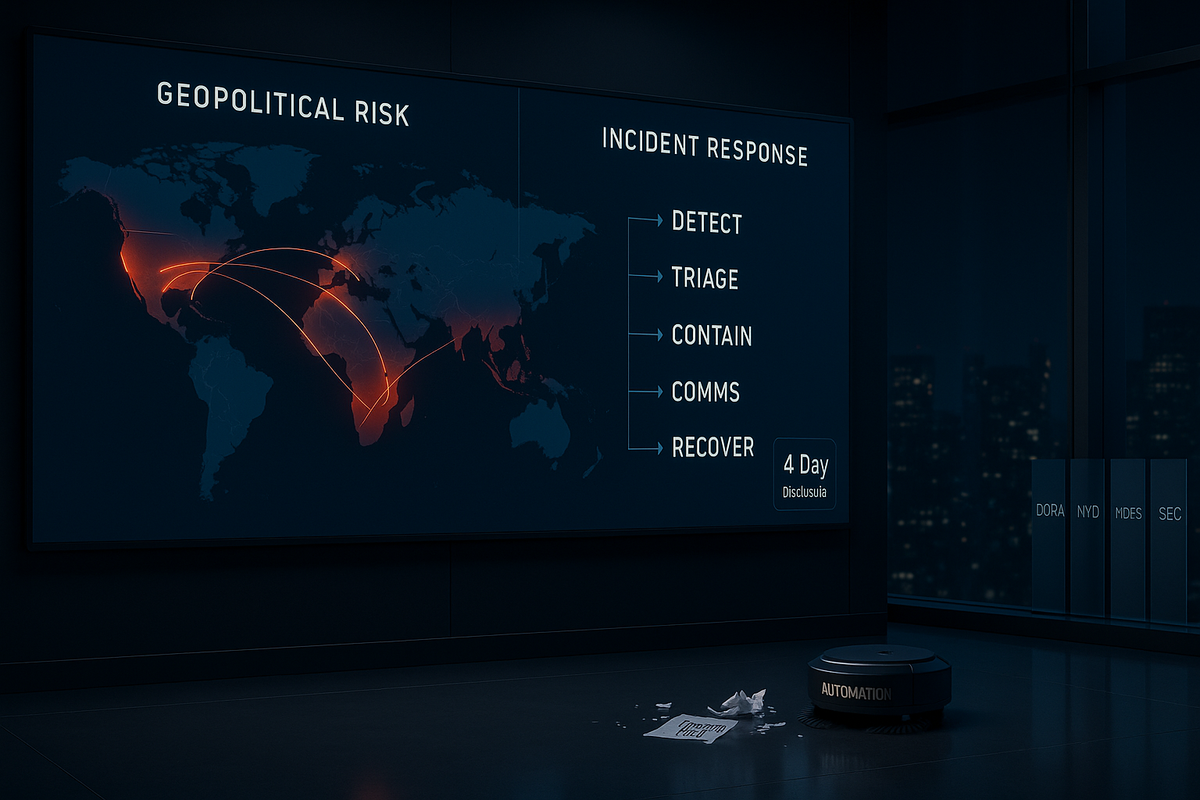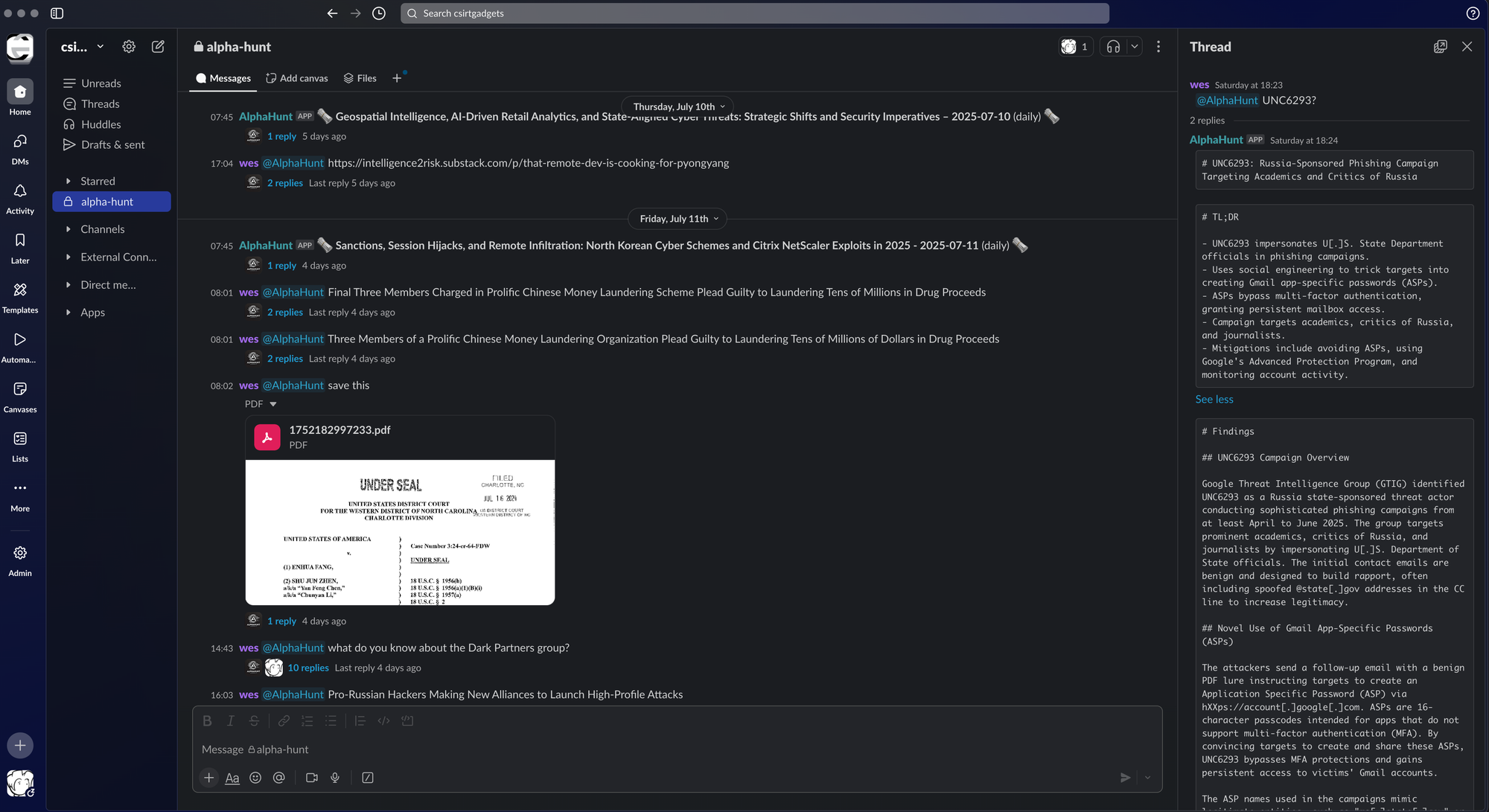Blended Geopolitical-Cyber Intelligence: Financial Sector’s Quiet Shift
Financial institutions are quietly overhauling cyber defenses, blending geopolitical risk with threat intelligence to counter state-sponsored attacks and regulatory pressure. This shift is driving new investments in automation, incident response, and sector-wide collaboration..

TL;DR
Key Points
- Integrate geopolitical risk into cyber threat intelligence and incident response
- Automate threat triage and scenario planning using advanced platforms
- Regularly test crisis communications and backup channels to avoid operational disruption
- Track evolving regulatory mandates (DORA, NYDFS, SEC) and automate compliance
- Prioritize sector collaboration and intelligence sharing to close resource gaps
The story in 60 seconds
Financial services are facing a surge in state-sponsored cyber threats, with ransomware and supply chain attacks disrupting operations and exposing systemic risk. Regulatory frameworks (DORA, NYDFS, SEC) now require explicit integration of geopolitical risk into cyber programs, driving investment in threat intelligence, automation, and crisis simulation. Case studies (ICBC ransomware, UK bank’s blended intelligence team) show that operationalizing geopolitical-cyber intelligence and automating workflows accelerate detection and response, but smaller institutions struggle with resource and compliance burdens.
Sector-wide, organizations are embedding geopolitical scenarios into risk management, leveraging threat intelligence platforms, and participating in intelligence sharing. Persistent challenges include attribution, data gaps, and regulatory complexity. The next 12–24 months will see increased automation, AI-driven analytics, and harmonization of compliance—yet adversaries are expected to evolve, exploiting supply chain and geopolitical tensions.
AlphaHunt
Stop doomscrolling, start decisioning. We chewed through the muck so your team doesn’t have to. → Subscribe! • Forward to your on-call lead.
(Have feedback? Did something resonate with you? Did something annoy you? Just hit reply! :))
Why it matters
SOC
- Monitor for ransomware, supply chain compromise, and credential abuse
- Watch for anomalous communications during crisis events (e.g., USB, personal email)
- Flag third-party and executive impersonation attempts tied to geopolitical flashpoints
IR
- Preserve evidence of initial access (phishing, supply chain), lateral movement, and data encryption
- Triage incidents for state-sponsored TTPs (MITRE ATT&CK mapping)
- Document and test secure backup communications in IR playbooks
SecOps
- Deploy and automate threat intelligence platforms with geopolitical modules
- Enforce zero trust and privileged account management
- Regularly simulate crisis scenarios, including supply chain and ransomware events
Strategic
- Brief boards on geopolitical cyber risk posture and regulatory exposure
- Invest in blended intelligence teams and cross-functional training
- Participate in sector-wide intelligence sharing (FS-ISAC, WEF, CERTs)
See it in your telemetry
Network
- Detect lateral movement and data exfiltration tied to ransomware and supply chain compromise
- Monitor for anomalous outbound connections during crisis events (e.g., unsanctioned email, USB device activity)
- Track third-party and vendor access patterns for signs of compromise
Endpoint
- Alert on credential theft and privilege escalation
- Flag execution of unauthorized backup or communication tools during incidents
- Monitor for deployment of known ransomware (Conti, TrickBot) and APT toolkits
High Impact, Quick Wins
- Automate threat triage and scenario planning for geopolitical flashpoints using threat intelligence platforms
- Test and secure backup communication channels; remove reliance on personal email/USB for crisis response
- Map and regularly update incident response plans to MITRE ATT&CK TTPs for state-sponsored actors
AlphaHunt
Ready to level up your intelligence game?
The Quiet Shift..
Executive Summary
Financial services organizations are significantly increasing cybersecurity investments and integrating geopolitical risk assessments in response to escalating state-sponsored cyber threats and global tensions. This shift is driven by a surge in sophisticated attacks (notably ransomware and APTs), regulatory mandates (DORA, NYDFS, SEC), and the operational imperative to protect critical infrastructure and maintain trust. Sector-wide, organizations are operationalizing geopolitical intelligence through blended intelligence teams, advanced threat intelligence platforms, and cross-functional risk management. However, challenges persist, including regulatory complexity, skills shortages, and the evolving tactics of nation-state actors.
Sector-Wide Investment Trends
- Rising Investment: Financial institutions have increased cybersecurity budgets year-over-year, focusing on advanced threat detection, supply chain risk, and resilience. According to the World Economic Forum, 72% of organizations reported a rise in cyber risks, and 60% stated that geopolitical tensions have influenced their cybersecurity strategy.
- Key Drivers:
- Escalating state-sponsored attacks (notably from Russia, China, North Korea)
- Regulatory requirements (DORA, NYDFS, SEC)
- Board-level prioritization of cyber resilience and operational continuity
- Investment Focus:
- Threat intelligence platforms with geopolitical context
- Zero trust architectures and advanced identity management
- Enhanced incident response and crisis simulation
- Supply chain and third-party risk monitoring
- Sector Data Points:
- FS-ISAC’s 2024 report highlights increased threat intelligence sharing and a focus on AI, supply chain, and hacktivism as top risks.
- The OCC’s 2025 report emphasizes the importance of operational resilience and third-party risk management in the face of disruptive attacks.
Regulatory Drivers: DORA, NYDFS, SEC
- DORA (EU): The Digital Operational Resilience Act, effective January 2025, mandates robust ICT risk management, threat-led penetration testing, and incident reporting, with explicit requirements to consider geopolitical risks in third-party and supply chain assessments.
- NYDFS (New York): The 2023–2025 amendments require regular risk assessments (including geopolitical threats), mandatory incident reporting, and enhanced governance for covered entities.
- SEC (US): The SEC’s 2023–2024 rules require public companies to disclose material cybersecurity incidents and describe processes for assessing and managing risks, including those from geopolitical tensions.
Case Studies: State-Sponsored Attacks (2023–2025)
Case Study 1: ICBC Ransomware Attack (2023)
- Incident: In November 2023, the Industrial and Commercial Bank of China’s (ICBC) U.S. financial services division was hit by a ransomware attack attributed to a Russian-speaking group. The attack disrupted U.S. Treasury market operations and forced the bank to use personal email and USB drives for critical transactions.
- Impact: Major operational disruption, highlighting systemic risk and the need for robust incident response and secure backup communication channels.
- Lessons Learned: Importance of secure, tested incident response plans and the dangers of relying on insecure communication methods during crises.
Case Study 2: Blended Intelligence at a Large UK Bank (2024–2025)
- Incident/Response: A major UK bank operationalized a blended intelligence team, integrating geopolitical, cyber, and physical risk analysis. This approach enabled rapid triage of threats, automated workflows for executive impersonation, and scenario planning for geopolitical flashpoints (e.g., Russia/Ukraine, China/Taiwan).
- Impact: Improved threat detection, faster response, and better alignment of intelligence with business risk.
- Lessons Learned: Centralizing intelligence and automating workflows enhances resilience and supports business decision-making.
Operationalization of Geopolitical Intelligence
- Integration Approaches:
- Embedding geopolitical risk scenarios into enterprise risk management and cyber risk quantification
- Leveraging commercial/government threat intelligence feeds with geopolitical context
- Establishing cross-functional teams for horizon scanning and scenario planning
- Participating in sector-wide intelligence sharing (FS-ISAC, WEF, national CERTs)
- Tools and Frameworks:
- Threat intelligence platforms (e.g., ThreatConnect, Recorded Future) with geopolitical modules
- MITRE ATT&CK for mapping state-sponsored TTPs
- Regular crisis simulations and red-teaming based on geopolitical flashpoints
- Challenges:
- Attribution complexity and intelligence “noise”
- Resource constraints for smaller institutions
- Rapidly shifting geopolitical and regulatory landscape
Best Practices and Persistent Challenges
Best Practices
- Board-Level Engagement: Regular briefings on geopolitical cyber threats and risk posture
- Dynamic Risk Assessment: Continuous integration of geopolitical intelligence into risk models and incident response plans
- Sector Collaboration: Active participation in FS-ISAC and public-private partnerships for intelligence sharing
- Regulatory Alignment: Proactive adaptation to evolving requirements (DORA, NYDFS, SEC) and transparent incident reporting
Persistent Challenges
- Data Gaps: Limited access to actionable, timely geopolitical intelligence
- Attribution: Difficulty in confidently attributing attacks to state actors
- Resource Disparity: Smaller institutions struggle to match the investment and expertise of larger peers
- Regulatory Complexity: Navigating overlapping and evolving global regulatory frameworks
Recommendations, Actions, Suggested Pivots, Forecasts, Next Steps and References..
(Specially baked, for Paid Subscribers..)






